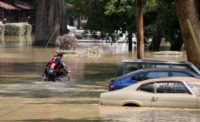The estimate also does not include some of the more projects envisioned in the report that require further study, like the construction of a so-called Seaport City, just south of the Brooklyn Bridge in Manhattan, modeled after Battery Park City, which would protect Lower Manhattan, said the NY Times.
The administration said that roughly half of the currently estimated $20 billion cost over the next decade would come from federal and city money that has already been allocated. An additional $5 billion would be covered by aid that Congress has already approved. Most of that money was allotted, through a variety of programs, in the aftermath of Hurricane Sandy, according to the report.
The city would have to raise an additional $5 billion.
In the first phase of building defenses, the report calls for erecting barriers at Hunts Point in the Bronx to protect the food distribution center, on the East Harlem waterfront along Franklin D. Roosevelt Drive, on the Upper East Side where most of the city’s hospitals are concentrated, on the Lower East Side, in Chinatown, in the financial district and in Red Hook, Brooklyn, said the NY Times.
On Staten Island, the plan calls for a system of permanent levees.
Along some parts of the coast, stone or concrete bulkheads would be installed, while in other places, dune systems would be built.
The city’s power infrastructure also should be better protected, the report said. Currently, 53 percent of power plants are in threatened neighborhoods. By the 2050s, according to the report, 97 percent will be located there. The plan calls for the city’s hospitals to protect electrical equipment, emergency power systems and water pumps better by 2030.






